Dry Drawing Media Consists Of Coloring Agents, Which Are Mixed With What To Hold Them Together?
Fixative is a clear liquid made with resin or casein and something to evaporate quickly, like alcohol. It is usually sprayed onto a dry media artwork to stabilise the pigment or graphite on the surface and to preserve finished artwork from dust. It is similar to varnish.
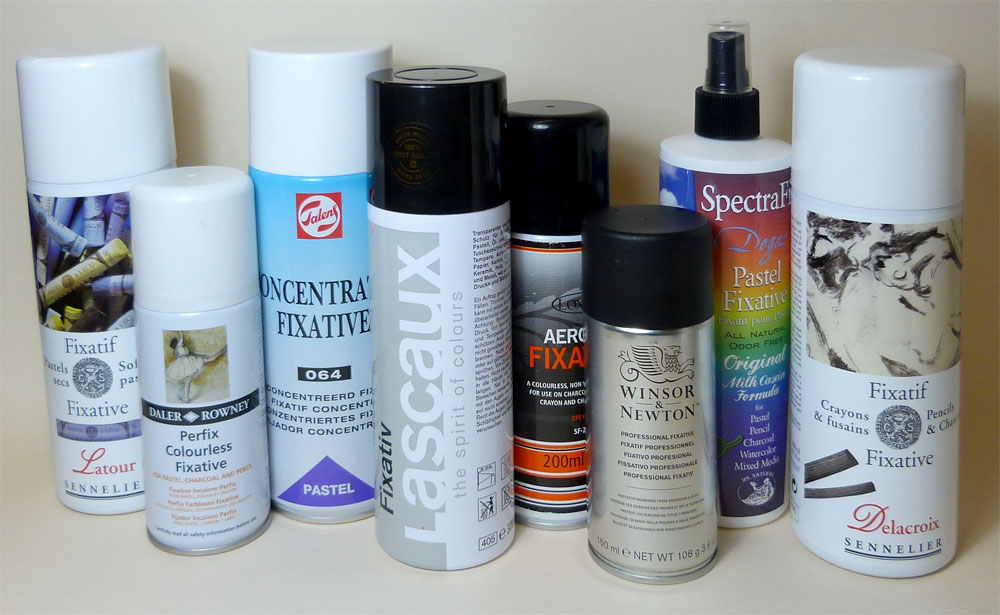
A Comparison of Brands of Fixatives
At Jackson's, we stock 10 makes of fixative plus some varnishes that might be used as fixatives. I wanted to know how they differed.
The 2 main things you want to know about a fixative is:
1. How well does it fix the dry media onto the surface to prevent smudging?
2. How much does it alter the appearance of the artwork?
Some artists don't use fixative because of the negative colour changes, especially to pastels and coloured papers, these artists frame the un-fixed artwork behind glass. Other artists use a fixative but then afterwards add back the ruined highlights to the artwork. Is there a fixative that secures the pigment to the surface without changing the colour?
To jump straight to the conclusions at the end – click here.
Tests I set up to judge the fixatives
I tested 10 spray fixatives and 4 spray varnishes.
Fixatives
- Sennelier Latour Spray Fixative for Pastels
- Lascaux Fixative
- Winsor & Newton Professional Fixative
- SpectraFix Spray Fixative
- Sennelier Delacroix Spray Fixative for Pencils and Charcoal
- Royal Talens Concentrated Fixative Spray
- Daler Rowney Perfix Colourless Spray
- Loxley Soft Pastel Fixative
- Jackson's Pastel Fixative
- Sennelier HC10 Universal Fixative
Varnishes
All the varnishes contain UV protection to prevent fading.
- Golden Archival MSA Spray Varnish (matt)
- Liquitex Spray Varnish (gloss)
- Winsor & Newton Professional Varnish (matt)
- Lascaux UV (matt)

Smudging
Does it reduce smudging?
How many applications does it take to do so?
Does it vary between pastel, charcoal and graphite?
Is it affected by moisture (for humidity or mixed-media uses)?
To clearly see the smudging I set up black on white charts for each of the 12 makes with a light and a heavy application of black pastel, a light and a heavy application of charcoal and a band of graphite. I also included a light band of black pastel at the bottom that was for testing the reaction to a wet finger.
I then applied the fixatives in 3 columns: 1, 2, and 3 coats, plus a column un-fixed. I applied it from a short distance, so the application was fairly heavy. After everything was well dried I did smudge tests with my fingers to see how well the fixative worked.
Results
I describe the characteristics of each fixative and the results of the smudge tests.
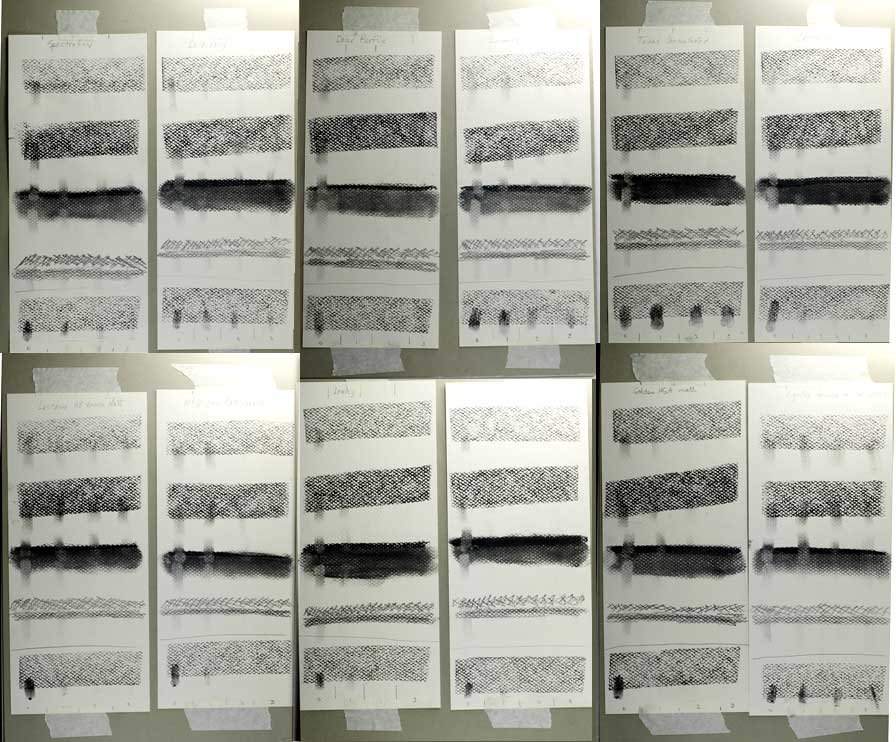
The test completed.
Each card has 4 columns.
l-r: no fix, 1, 2, 3, coats.
top-bottom: light and heavy applications of pastel, light and heavy applications of charcoal, graphite and light application of pastel for testing with wet finger.
Sennelier Latour Spray Fixative for Pastels
Quick dry. Low odour.
Not much smudge protection until 3 coats.
Not water resistant.
Lascaux Fixative
Quick dry. Strong odour.
Fair smudge protection after 2 coats, except on thick pastels and thick charcoal.
Good water resistance.
Winsor & Newton Professional Fixative
Medium quick dry. Medium strong odour.
Good smudge protection after 1 coat, better after 2 coats.
Good water resistance after 2 coats.
SpectraFix Spray Fixative
The only water-based fix, it is very slow-drying and wets the paper so unless you are using heavy card it might buckle. It is the only pump spray tested as well. You should be careful of spraying too close as the burst blows any loose pigment all over.
Low odour.
Good smudge protection after 3 coats for all but heavy charcoal.
Moderately poor water resistance.
Sennelier Delacroix Spray Fixative for Pencils and Charcoal
Fast Drying. Low odour.
Moderately good smudge protection after 3 coats.
Moderately poor water resistance.
Royal Talens Concentrated Fixative Spray
Medium quick drying. Very strong odour but perfumed to smell of something like washing up liquid.
Good smudge protection after 1 coat.
Not water resistant.
Daler Rowney Perfix Colourless Spray
Slow drying. Strong odour.
Perfect (best) smudge protection after 1 coat.
Very water resistant.
Loxley Soft Pastel Fixative
Slow dry. Stong odour.
Good smudge protection after 1 coat for graphite and light application of pastel. Good smudge protection after 2 coats for all else.
Water resistant after 2 coats.
Golden Archival MSA Spray Varnish (matt)
Slow drying. Very strong odour.
Good smudge protection after 1 coat for graphite. Good smudge protection after 2 coats for all else except heavy charcoal which took 3 coats.
Water resistant after 1 coat.
Easy to over saturate the paper and the oily nature of this spray creates a transparency to the paper like chip fat on kitchen roll.
Liquitex Spray Varnish (gloss)
Fast dry. Medium odour.
Poor smudge protection even after 3 coats except moderately on graphite after 3 coats.
No oily saturation like above, at all.
Not water resistant.
Winsor & Newton Professional Varnish (matt)
Medium fast dry. Strong odour.
Good smudge protection after 2 coats.
Water resistant after 2 coats.
Easy to over saturate the paper and the oily nature of this spray creates a transparency to the paper like chip fat on kitchen roll.
Lascaux UV (matt)
Quick dry. Strong odour.
Moderate smudge protection of graphite and light charcoal after 2 coats.
Moderately poor on the rest even after 3 coats.
Moderately good water resistance after 2 coats.
Like the Liquitex this was ok on paper, did not leave an oily saturation.
What I Learned
These four gave the best smudge protection after 1 or 2 coats – in order:
1. Daler Perfix
2. Winsor Fixative
3. Talens
4. Loxely
and the next best was
5. Lascaux Fixative
The strong smell of the paper for days afterwards makes me rule out the Talens and the Golden.
Notes:
Drying time
Drying time was based on white paper slightly yellow-ish while wet and lightening back to white when dry – so then I could apply the next coat.
Fast drying = 10 minutes
Varnishes:
When applying the fixatives I used my bare hand to hold the masking card and washed any over-spray of the fix off my hand each time with no residue. The varnishes were different – they felt oily and left a bad smell on my skin so I used gloves after the first one.

Colour Change
For most artists colour change is bad. You have created your artwork with consideration for lights and darks and if you simply want to protect your drawing or painting from smudging damage, colour changes to your artwork can be frustrating. Artists often have to add back the highlights as the whites are ruined by fixatives. Colours can be dulled. Dark papers can become darker as well.
If you use fixative as part of your creating process and will continue working on the drawing, any colour change may not be a factor.
To make the colour change very apparent I set up a medium-dark paper with black pastel, white pastel and black layered with white plus a band of charcoal. The most important thing was the white pastel on top of the black- if this area turned black the white on top had been ruined.
I then applied the fixatives in alternating columns: un-fixed, 1 coat, un-fixed, 2 coats for each brand of fixative. I applied it from a short distance, so the application was fairly heavy (a back-and-forth spray at 25cm).
Results
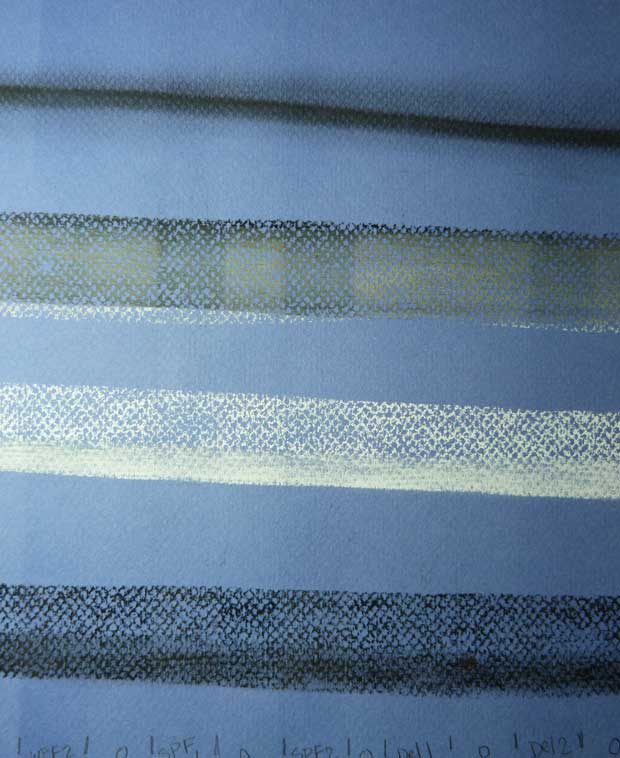
l-r: Spectrafix and Delacroix. Changed the colours.
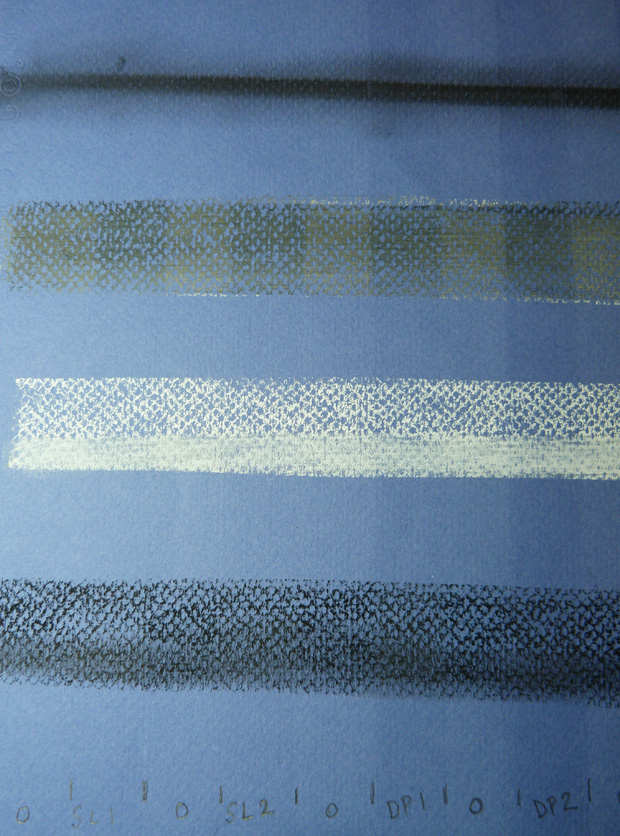
l-r: Sennelier Latour and Daler Perfix were not good about colour changes especially the important white on top of black.
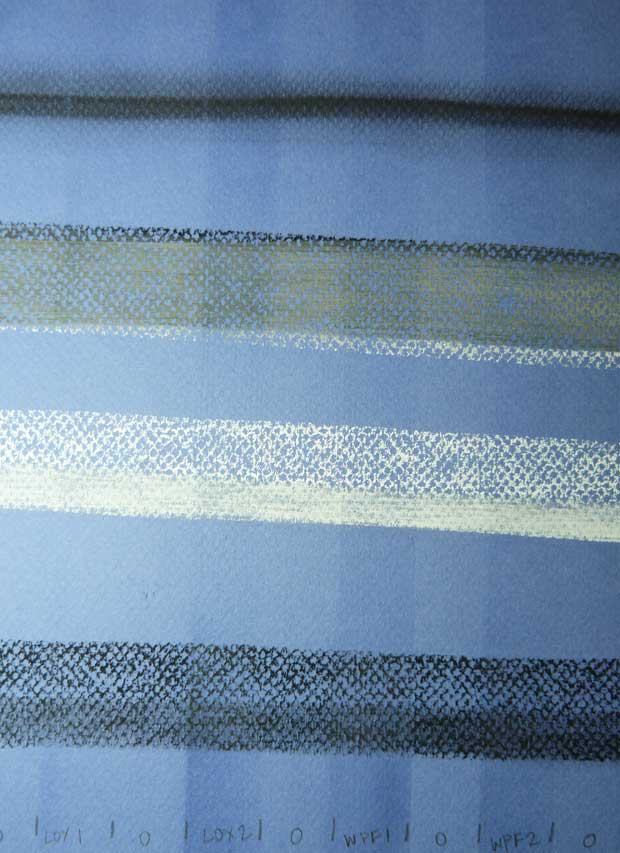
Loxley and Winsor Fixative were not good about colour changes.
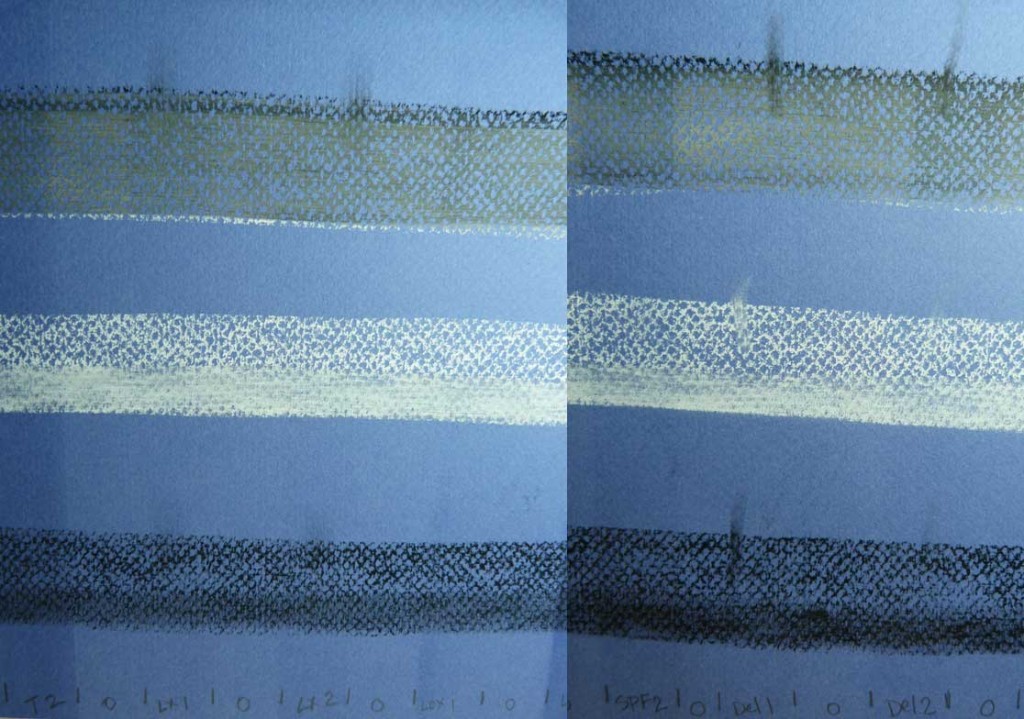
Lascaux and Delacroix were good about colour but smudged
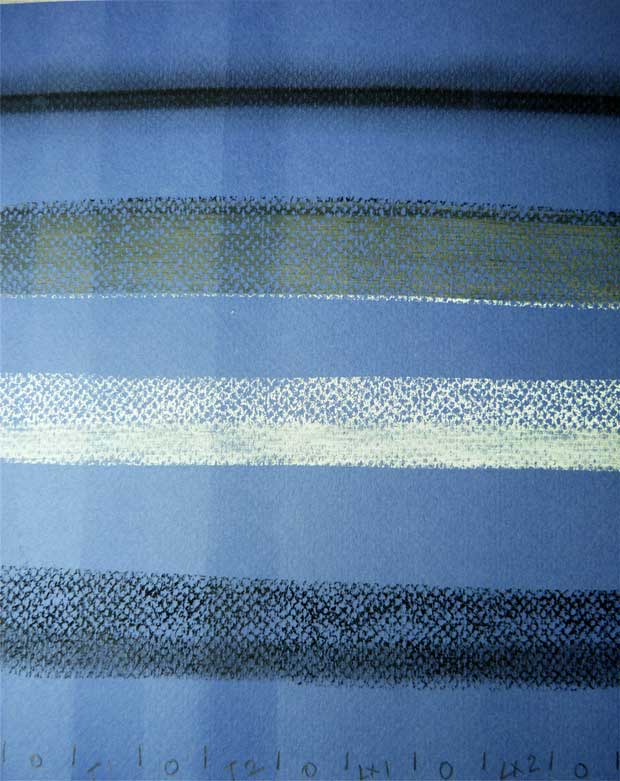
l-r: Talens and Lascaux Fixatives. Lascaux almost no colour change.
What I Learned
Saturation of the pastel with fixative dulls it.
But that is also what fixes it.
The brands that did the best in the smudge test were among the worst in the colour change test and visa-versa.
Lascaux fixative changes the colour the least.
Testing for a Balance of Both
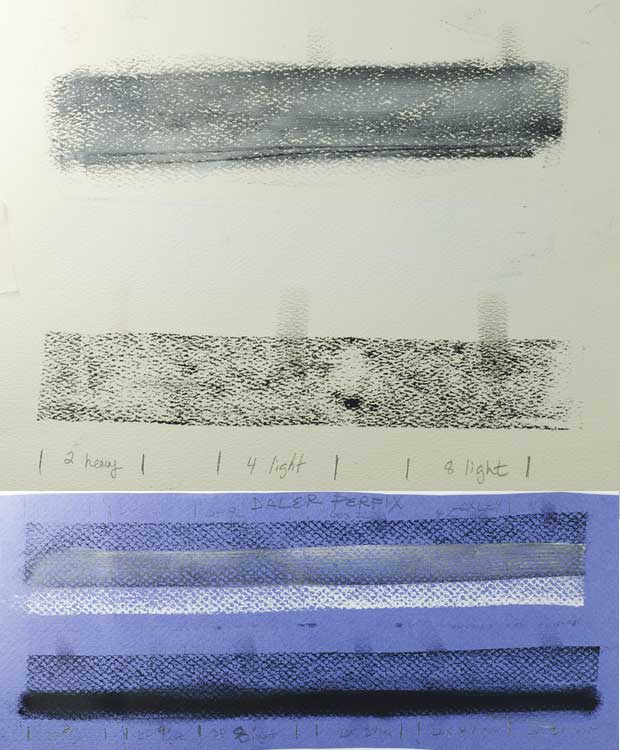
Testing winners for distance and amount of application for a good balance of smudge protection and least colour change.
After I saw the results of the colour tests and the smudge tests I tried a few more things with the winners of each to try to get a balance between smudge protection and least colour change.
I tried spraying the brand most successful at reducing smudging, Daler-Rowney Perfix, from a far distance (a puff at 50cm) to allow a very light layer to fall. But 20 very light layers did not fix as well as one fairly heavy layer (a back-and-forth spray at 25cm). I tried a saturated spraying with the make that did the best in the colour change test, Lascaux Fixative, which did quite well, though I never was able to make it completely smudge-proof.
After trying different possibilities I came to the conclusion that it is a fine line to walk – until it is saturated the pastel is not fully fixed but a partial saturation will provide some protection from smudging while changing the appearance the least. So in the end it depends on which is more important to you- the smudge protection or the colour appearance and you need to decide to go for more saturation or less saturation depending on which is more important.
Distance from the artwork will control the amount of spray to not soak the paper but to get a good even coat. Too far and it won't coat well enough.
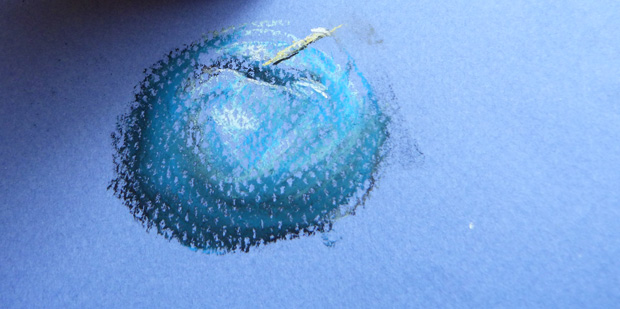
Apple sketch before testing for best amounts of the two winners.
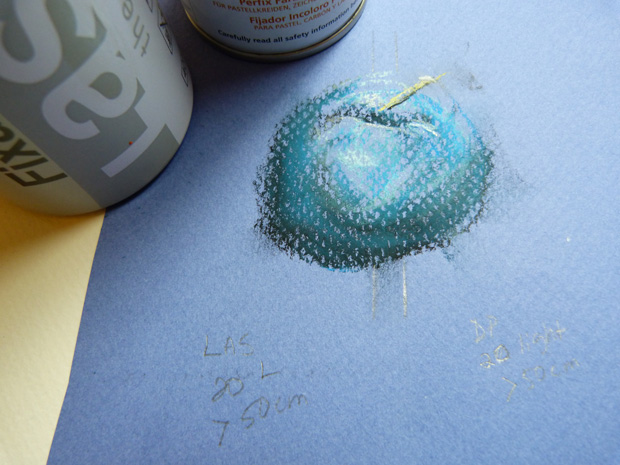
Apple sketch after testing of winners.
It is possible to get a moderately-fixed pastel drawing that does not lose the white highlights.
Conclusions
For my work I will probably usually choose to be balanced somewhere in the middle to get some smudge protection, though not perfect and some colour change, though not much. To do that I will apply a somewhat lighter application of Daler Perfix or Winsor Fixative or a somewhat heavier application of the Lascaux Fixative.
Click on the underlined links of each brand of fixative at the top of the article or here to go to the Pastel Fixatives on the Jackson's Art Supplies website.
Postage on orders shipped standard to mainland UK addresses is free for orders of £39 or more.
Dry Drawing Media Consists Of Coloring Agents, Which Are Mixed With What To Hold Them Together?
Source: https://www.jacksonsart.com/blog/2014/08/29/fixatives-are-not-all-the-same/
Posted by: sheltonhemperess.blogspot.com

0 Response to "Dry Drawing Media Consists Of Coloring Agents, Which Are Mixed With What To Hold Them Together?"
Post a Comment